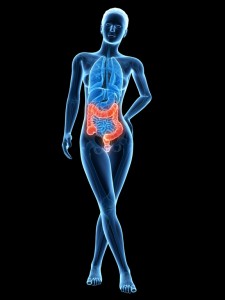Introduction
Irritable bowel syndrome presents with an intestinal function, which is certainly pathological and can be quite disabling. Another name for it is “spastic colon”, because many patients complain of significant bowel spasms. Some health providers still use this alternative term. As has been noted, there are suggestions that hormonal factors maybe important in the causation of irritable bowel syndrome.
This syndrome is especially more common among women and it has been expressly postulated that female hormones may have something to do with the pathophysiology of irritable bowel syndrome, while testosterone may be associated with a calming effect on the gastrointestinal tract.
Parasympathetic nervous system
At the present time, however, I would consider this only an interesting theory. What has been proven though is that the complex regulation of circular and longitudinal smooth muscles that make up the bowel wall, is surprisingly stimulated by the parasympathetic nervous system. The tone of it is increased in patients with irritable bowel syndrome when compared with a group of normal volunteers ( Ref. 14). Other physical differences have been measured.
In fact, Blomhoff et al.(Ref. 15) have notably measured the rectal pressure using rectal probes and found that words that caused symptoms of anxiety, anger or sadness caused significant increase (rectal spasms) or decrease of rectal tone in patients with documented irritable bowel syndrome, but not in normal subjects.
Slower response to serotonin signals
Other authors (Ref. 16) have extensively reviewed the literature and came surprisingly to the following conclusions: there is good evidence that in irritable bowel syndrome there is specifically a slower than normal response to serotonin signals in the bowel wall. In women often particularly there can be significant changes of the anorectal opening mechanism because of a frequent pelvic floor descend. This latter observation might be related to child bearing or could also be related to chronic constipation. The authors of Ref. 16 concluded that specific neurohormonal stimulation with newer medications stimulating specific receptors likely will provide more answers in the future. Another paper (Ref. 17) documented that in 33% of patients with irritable bowel syndrome there is a significant bile acid malabsorption, which as we will see below has important therapeutic implications.
Irritable bowel syndrome symptoms
Generally speaking irritable bowel syndrome occurs first in the teens or early twenties explicitly, but then frequently tends to become chronic. The patient chiefly complains of abdominal bloating and distension. Bowel movements lead to a marked relief of pain. There is often mucous in the stools. After a bowel movement there is often a feeling that the rectum seems like it was not cleaned out entirely, even though it was. These symptoms are brought on by food intake or by stress and they always occur during the waking period. At nights most patients have no pain and they are not awakened by symptoms from the irritable bowel syndrome. If there is a different pattern, then further investigations should be done to rule out an occult infectious process, celiac disease or Crohn’s disease.
Two types of irritable bowel syndromes have been defined: a diarrhea-predominant irritable bowel syndrome and a constipation-predominant irritable bowel syndrome.
A) Diarrhea-predominant irritable bowel syndrome (IBS with diarrhea)
These patients have indeed an abnormal bowel pattern with a tendency of express overstimulation where diarrhea is a major feature on top of the other symptoms mentioned above. Diarrhea associated with pain is triggered by getting up in the morning or immediately after a meal. Bloating and rectal urgency are very common. If there is no pain associated with the diarrhea, then the physician should look for alternative causes of this symptom, ruling out such as celiac disease, Crohn’s disease and others.
B) Constipation-predominant irritable bowel syndrome (IBS with constipation)
This form of irritable bowel syndrome has a bowel pattern with a tendency of “sluggishness”. Bowel habits fluctuate between periods with constipation and a normal pattern. There is a unique tendency to have pains in one area of the colon (large bowel). Eating would often trigger pains in that area, which can be of a continuous dull nature or be more colicky. An effective bowel movement will often surprisingly lead to relief of the symptoms. The stools usually contain white or clear mucous. The patient complains of general bloating, nausea, physical gas pains and difficulties to digest food.
Diagnostic tests
Notably, various questionnaires (Rome and Manning criteria, Ref. 18) help the physician to establish whether or not a particularly specific bowel pattern will qualify for the diagnosis of irritable bowel syndrome.
The physician will do a thorough examination and possibly also a few tests to rule out other causes of similar symptoms. The history will establish when the symptoms have started and will include questions around the symptoms discussed above. However, there will also have to be a discussion of emotional and personal problems as they can actually trigger the condition. Rather than all in one day the physician may want to see the patient on several occasions, do some minor investigations and re-examine the patient on different days, filling in the unexpected gaps that were not apparent on the first visit. Although there might be tenderness of the abdomen, in essence, with irritable bowel syndrome there is no true positive finding.
Rectal examination, pelvic examination, colonoscopy
However, the examinations should include a rectal examination in both sexes and should include a pelvic examination in women in order to rule out other pathology (pelvic organ prolapse, rectocele, cystocele and prolapse of the uterus). The doctor may want to do a proctosigmoidoscopy. With this test the doctor uses a fiberoptic instrument to inspect the rectum and the sigmoid colon. On the other hand, the doctor may feel that a colonoscopy is necessary. This will enable the doctor to rule out other diseases in the colon and rectum. There are many other diseases, which may mimic irritable bowel syndrome and it is the responsibility of the doctor to rule this out. The physician needs to rule out cases of endometriosis, hypothyroidism, colonic polyps or colon cancer, just to mention a few examples.
Treatment
At one point all the tests are complete and the physician can confidently say that the diagnosis is irritable bowel syndrome. It is important that the doctor takes some time to explain to the patient in detail that the tests were normal. Also he/she needs to especially explain what the diagnosis of irritable bowel means and that it is definitely not cancer.
It is also important that the doctor hears the patient’s concerns and then discusses them. This interaction and mutual respect will be the foundation for an ongoing therapeutic relationship. The purpose of the therapy is to give the patient relief of the symptoms. If stress is a large component of a certain patient’s symptoms, it might be worthwhile to arrange for some counseling regarding this aspect. Hypnotherapy in this context can sometimes also give wonderful results.
Two kinds of irritable bowel syndrome
From a physical point of view Camilleri (Ref. 19) mentioned that there is a difference in treatment for the constipation-predominant versus the diarrhea-pre-dominant irritable bowel syndrome. The constipation-predominant irritable bowel syndrome requires a high fiber diet with 12 grams of fiber per day. Tegaserod, a serotonin agonist, certainly decreases the bowel transit time in the colon (Ref.20), which likely will be very useful as an adjunct to the fiber treatment in the constipation-predominant irritable bowel syndrome patient.
Diarrhea-predominant irritable bowel syndrome
In contrast, the diarrhea-predominant irritable bowel syndrome patient needs a normal dietary intake. Serotonin receptor subtype inhibitors such as ondansetron (brand name: Zofran) or granisetron (brand name: Kytril) will tone down the hyperactivity of the bowel. This will suppress vomiting and help against pain and diarrhea (Ref. 21). Patients can use loperamide (brand name: Imodium, Loperacap) just before a meal to help with diarrhea, but researchers do not recommend long-term use of it. The reason namely is that tolerance to this medication can develop. Antidepressants in doses much lower than normally used for depression will help to alleviate the psychosomatic component of irritable bowel syndrome.
Bile acid sequestrants for diarrhea-predominant irritable bowel patients
I explain earlier, in Ref. 17 the authors noticed that there was no reabsorption of bile salts in diarrhea-predominant irritable bowel syndrome cases. They found further that only 15% of these patients responded to the usual therapy for irritable bowel syndrome. However, following a prescription of bile acid sequestrants led to a 70% response in these patients. With this in mind it indicates that all diarrhea-predominant irritable bowel patients should receive bile acid sequestrants as a dietary supplement.
References
1. M Frevel Aliment Pharmacol Ther 2000 Sep (9): 1151-1157.
2. M Candelli et al. Panminerva Med 2000 Mar 42(1): 55-59.
3. LA Thomas et al. Gastroenterology 2000 Sep 119(3): 806-815.
4. R Tritapepe et al. Panminerva Med 1999 Sep 41(3): 243-246.
5. The Merck Manual, 7th edition, by M. H. Beers et al., Whitehouse Station, N.J., 1999. Chapters 20,23, 26.
6. EJ Simchuk et al. Am J Surg 2000 May 179(5):352-355.
7. G Uomo et al. Ann Ital Chir 2000 Jan/Feb 71(1): 17-21.
8. PG Lankisch et al. Int J Pancreatol 1999 Dec 26(3): 131-136.
9. HB Cook et al. J Gastroenterol Hepatol 2000 Sep 15(9): 1032-1036.
10. W Dickey et al. Am J Gastroenterol 2000 March 95(3): 712-714.
11. M Hummel et al. Diabetologia 2000 Aug 43(8): 1005-1011.
12. DG Bowen et al. Dig Dis Sci 2000 Sep 45(9):1810-1813.
13. The Merck Manual, 7th edition, by M. H. Beers et al., Whitehouse Station, N.J., 1999.Chapter 31, page 311.
14. O Punyabati et al. Indian J Gastroenterol 2000 Jul/Sep 19(3):122-125.
15. S Blomhoff et al. Dig Dis Sci 2000 Jun 45(6): 1160-1165.
16. M Camilleri et al. J Am Geriatr Soc 2000 Sep 48(9):1142-1150.
More references
17. MJ Smith et al. J R Coll Physicians Lond 2000 Sep/Oct 34(5): 448-451.
18. YA Saito et al. Am J Gastroenterol 2000 Oct 95(10): 2816-2824.
19. M Camilleri Am J Med 1999 Nov 107(5A): 27S-32S.
20. CM Prather et al. Gastroenterology 2000 Mar 118(3): 463-468.
21. MJ Farthing : Baillieres Best Pract Res Clin Gastroenterol 1999 Oct 13(3): 461-471.
22. D Heresbach et al. Eur Cytokine Netw 1999 Mar 10(1): 7-15.
23. BE Sands et al. Gastroenterology 1999 Jul 117(1):58-64.
24. B Greenwood-Van Meerveld et al.Lab invest 2000 Aug 80(8):1269-1280.
25. GR Hill et al. Blood 2000 May 1;95(9): 2754-2759.
26. RB Stein et al. Drug Saf 2000 Nov 23(5):429-448.
27. JM Wagner et al. JAMA 1996 Nov 20;276 (19): 1589-1594.
28. James Chin, M.D. Control of Communicable Diseases Manual. 17th ed., American Public Health Association, 2000.
29. The Merck Manual, 7th edition, by M. H. Beers et al., Whitehouse Station, N.J., 1999. Chapter 157, page1181.
30. Textbook of Primary Care Medicine, 3rd ed., Copyright © 2001 Mosby, Inc., pages 976-983: “Chapter 107 – Acute Abdomen and Common Surgical Abdominal Problems”.
31. Marx: Rosen’s Emergency Medicine: Concepts and Clinical Practice, 5th ed., Copyright © 2002 Mosby, Inc. , p. 185:”Abdominal pain”.
32. Feldman: Sleisenger & Fordtran’s Gastrointestinal and Liver Disease, 7th ed., Copyright © 2002 Elsevier, p. 71: “Chapter 4 – Abdominal Pain, Including the Acute Abdomen”.
33. Ferri: Ferri’s Clinical Advisor: Instant Diagnosis and Treatment, 2004 ed., Copyright © 2004 Mosby, Inc.
34. Suzanne Somers: “Breakthrough” Eight Steps to Wellness– Life-altering Secrets from Today’s Cutting-edge Doctors”, Crown Publishers, 2008








